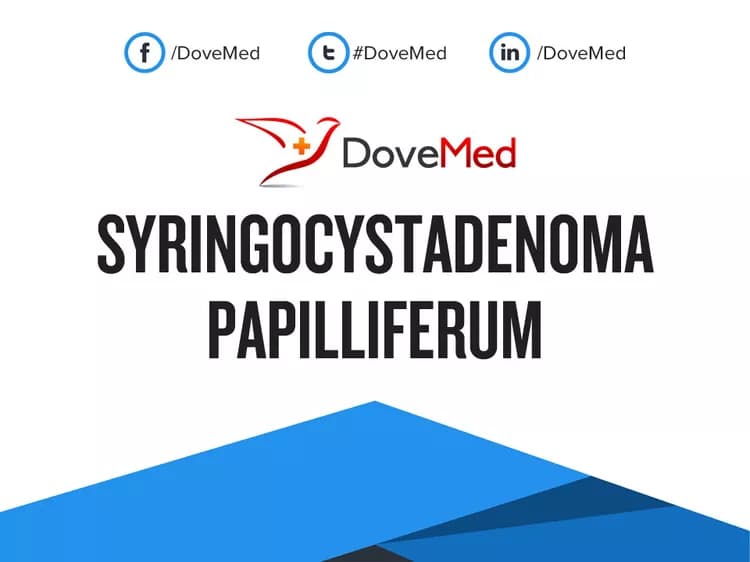What are the other Names for this Condition? (Also known as/Synonyms)
- Naevus Syringocystadenomatosus Papilliferus
- SP (Syringocystadenoma Papilliferum)
- Syringadenoma Papilliferum
What is Syringocystadenoma Papilliferum? (Definition/Background Information)
- Syringocystadenoma Papilliferum (SP) is a very rare, benign tumor (adnexal neoplasm) that can originate from the sweat glands
- There are three different types of sweat glands in the skin. These include the following:
- Apocrine sweat glands
- Eccrine sweat glands
- Sebaceous sweat glands
- Syringocystadenoma Papilliferum is a slow-growing and usually solitary tumor that occurs as a painful nodule. It is often seen in children and young adults and is generally seen in the head and neck region
- The cause of Syringocystadenoma Papilliferum is not yet well-established. In about one-third of the cases, nevus sebaceus is noted as a risk factor
- In a majority of cases, Syringocystadenoma Papilliferum is treated due to the pain it causes. A simple surgical excision of the tumor is considered curative
- The prognosis for Syringocystadenoma Papilliferum is excellent with suitable treatment. However, in rare cases, some syringocystadenomas are known to transform into malignant lesions
Who gets Syringocystadenoma Papilliferum? (Age and Sex Distribution)
- Syringocystadenoma Papilliferum is a rare tumor that can occur at any age, but it is more common in individuals who are less than 20 years old
- They may be seen in children too. Some are noticed at birth, and in such cases, these are called Congenital Syringocystadenoma Papilliferum
- Both males and females may be affected with equal incidence
- Individuals of all racial and ethnic background may be affected
What are the Risk Factors for Syringocystadenoma Papilliferum? (Predisposing Factors)
- Currently, nevus sebaceous has been identified as a risk factor for Syringocystadenoma Papilliferum in nearly 35% of the cases
It is important to note that having a risk factor does not mean that one will get the condition. A risk factor increases ones chances of getting a condition compared to an individual without the risk factors. Some risk factors are more important than others.
Also, not having a risk factor does not mean that an individual will not get the condition. It is always important to discuss the effect of risk factors with your healthcare provider.
What are the Causes of Syringocystadenoma Papilliferum? (Etiology)
- The cause of development of Syringocystadenoma Papilliferum is unknown
- Genetic mutations have been suspected by researchers in some cases
- Some researchers believe that these tumors arise from the eccrine or apocrine sweat gland
What are the Signs and Symptoms of Syringocystadenoma Papilliferum?
The signs and symptoms of Syringocystadenoma Papilliferum include:
- It usually occurs as papules on the skin, usually solitary (rarely multiple). They may appear like warts
- It is a slow-growing tumor; the papule may be painless and non-itchy
- Some tumors can be pigmented
- Syringocystadenoma Papilliferum can occur on any part of the body. However, they are commonly observed on the head and neck (scalp) region, and sometimes, on the trunk
- If they occur on the scalp, there could be an associated hair loss around the tumor
- Some childhood tumors can grow in size during puberty
How is Syringocystadenoma Papilliferum Diagnosed?
A diagnosis of Syringocystadenoma Papilliferum may involve the following:
- A thorough medical history and physical examination
- Dermoscopy: It is a diagnostic tool where a dermatologist examines the skin using a special magnified lens
- Wood’s lamp examination: In this procedure, the healthcare provider examines the skin using ultraviolet light. It is performed to examine the change in skin pigmentation
- Skin biopsy: A skin biopsy is performed and sent to a laboratory for a pathological examination. The pathologist examines the biopsy under a microscope. After putting together clinical findings, special studies on tissues (if needed) and with microscope findings, the pathologist arrives at a definitive diagnosis
Many clinical conditions may have similar signs and symptoms. Your healthcare provider may perform additional tests to rule out other clinical conditions to arrive at a definitive diagnosis.
What are the possible Complications of Syringocystadenoma Papilliferum?
Syringocystadenoma Papilliferum is a benign skin lesion that may cause the following complications:
- The tumors can ulcerate and bleed. This can cause secondary bacterial or fungal infections to develop (superimposed infections)
- Some individuals may have concerns regarding their cosmetic appearance
- In rare cases, some lesions are known to transform into cancerous tumors, such as basal cell carcinomas
How is Syringocystadenoma Papilliferum Treated?
The treatment of Syringocystadenoma Papilliferum may involve the following:
- The treatment is a complete surgical excision, which can result in a cure. Due to its potential for malignancy; in most cases, the tumors are surgically removed
- Follow-up care with regular screening and check-ups are important and encouraged
How can Syringocystadenoma Papilliferum be Prevented?
Currently, there are no known methods to prevent Syringocystadenoma Papilliferum occurrence.
What is the Prognosis of Syringocystadenoma Papilliferum? (Outcomes/Resolutions)
- The prognosis for Syringocystadenoma Papilliferum is excellent with appropriate treatment (surgery), since it is a typically benign tumor
- If any malignant transformation is noticed, the tumor is removed early to prevent adverse health outcomes. The prognosis is excellent with prompt diagnosis and treatment of malignant tumors
Additional and Relevant Useful Information for Syringocystadenoma Papilliferum:
- There is no evidence to prove that oily foods and chocolate-based products have an influence on its formation
- Cleaning the skin too hard with strong chemicals or soaps may aggravate the skin condition. Care must be taken avoid strong soaps and chemicals that could potentially worsen the condition
- The presence of dirt on the body is not a causative factor for the condition. However, it helps to be clean and hygienic, which may help the condition from getting worse
Related Articles
Test Your Knowledge
Asked by users
Related Centers
Related Specialties
Related Physicians
Related Procedures
Related Resources
Join DoveHubs
and connect with fellow professionals



0 Comments
Please log in to post a comment.